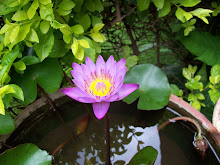 The Anthurium never fails to attract people with the stylish beauty of its flowers.
The Anthurium never fails to attract people with the stylish beauty of its flowers. It is also called the Flamingo Plant and the Boy Plant because of the structure of its inflorescence. Belonging to the Arum family,it is the native of tropical America, introduced to India not long ago. Our neighbouring state of Kerala leads in its cultivation. The flowers and plants of anthurium are exported.
It is also called the Flamingo Plant and the Boy Plant because of the structure of its inflorescence. Belonging to the Arum family,it is the native of tropical America, introduced to India not long ago. Our neighbouring state of Kerala leads in its cultivation. The flowers and plants of anthurium are exported.The anthurium is easy to grow in tropical regions. It flowers through the year and the flowers last for a long time. The flowers look great in a flower arrangement.












